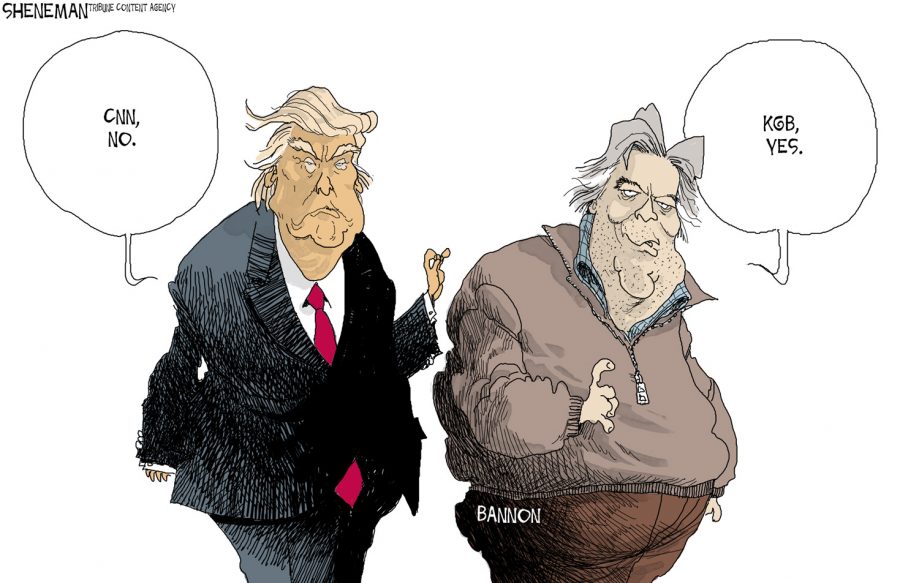The myth of the liberal media bias
This political cartoon features President Trump (left) and Trump’s Chief of Strategist Steve Bannon (right). Trump has called CNN “fake news.”
Feb 27, 2017
“The liberal media” is a hot topic in the United States. The issue of a biased media has become one of the largest in the nation. A Gallup poll from November 2016 showed 52 percent of Americans thought mass media was biased towards Hillary Clinton, compared to just 8 percent believing media favored Trump.
A 2015 Gallup poll found that just 32 percent of Americans held a fair amount or great deal of trust in mass media. The low amounts of trust were driven by Republican skepticism: 14 percent of Republicans had a fair amount or great deal of trust in news media, compared to 51 percent of Democrats and 30 percent of independents.
First, it is important to address — what is “the media?” We often think of the media as a single entity, but this is not true. “The media” is hundreds, perhaps thousands, of companies and outlets. The mass media is made up of several companies, and while I believe mass media is falling into the hands of too few people, they are still separate companies with important differences. We also have access to hundreds of smaller news companies all around the country, and even the world.
Different media outlets hold different political biases. Several wings of mass media are pro-conservative. While the mass media includes CNN and MSNBC, outlets commonly regarding as holding a liberal bias, the mass media also includes Fox News. Fox is not just a mass media company; it is the most watched news network in the country. Fox News is also infamous for its right-wing tilt.
Other mass media outlets that are generally conservative include the Wall Street Journal, the Washington Times and various conservative talk radio shows such as shows hosted by Rush Limbaugh and Sean Hannity. The media is not a single, liberal entity; it is made up of many companies with varying political leanings.
President Trump has ruthlessly attacked the American news media. Trump accuses outlets who air his dirt as “fake news,” and even banned CNN, the New York Times, Politico, the Los Angeles Times and BuzzFeed from a White House informal briefing last week. American political news media undoubtedly has a lot of problems, but Trump is “solving” the problem in the wrong way. Instead of addressing legitimate issues with political media, he attacks media with a clearly partisan agenda. It’s difficult to take Trump’s accusations of fake news seriously when he accuses the New York Times as fake news, but is totally okay with Breitbart; an outlet that has actually published fake news.
Trump brings a lot of his media problems on himself. Trump suffers from what Michael Baranowski calls the “Cleveland Browns problem.” The Cleveland Browns have received a lot of negative media coverage over the years. The Browns went 1-15 last season. Does this negative coverage originate from an anti-Browns bias in American sports media, or is it more likely the Browns receive negative coverage because they are a bad football team? If Trump would stop calling outlets who criticize him fake news, stop going on Twitter rampages, stop needlessly insulting people and start acting like a normal president he would find a lot of his media problems going away.
What are the real problems with political media? One is a lack of discussing the issues that should be the center of campaigns. Remember the substantive policy debates regarding the issues during the 2016 campaign? No, you don’t, because all the media covered throughout the campaign was whatever stupid thing came out of Donald Trump’s mouth that day. Even before 2016, media coverage focuses more on what the candidates did that day or their personal lives.
The answers to the issues facing our country cannot be found in a six second soundbite. Another problem is political media’s tendency to entertain rather than inform. The next is narrowcasting. Thanks to internet, social media and small media companies we can easily get our news from sources that hold political views similar to our; and research shows we do exactly that. Many Americans exist in an echo chamber of our views, and never have them challenged.
My best advice is to read your news. Print news tends to try to give you the whole story, and the context behind it instead of a 30 second summary. There is less of the incentive to entertain that exists in cable news. I recommend reading the New York Times and Des Moines Register; both of which are available for free in the Maucker Union.
Some think the Times leans left, but this is a product of its liberal opinion columns. The news itself is unbiased and reasonable. After all, the Times broke the story of Hillary’s email scandal in 2015. Perhaps Trump would be nicer to them if he remembered that.








